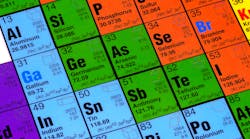Rare Earth Elements Are Increasingly Replaceable
At any manufacturing conference, there’s likely to be at least one panel on sustainability. These conversations often involve emissions, energy use, supply chain and recycling.
Materials science is one overlooked way to optimize sustainability, particularly for manufacturers in high-performance industries such as aerospace, automotive, medical devices and luxury goods. These applications often use alloys that include rare earth elements (REEs), which can be environmentally harmful to mine and process.
Rare earth elements aren’t just included in alloys because they sound exotic — they often enable necessary material properties in a component. Reducing or eliminating REEs dramatically reduces the environmental impact of a product and typically reduces materials costs, too. Digital transformation of materials engineering has created new opportunities to develop materials without REEs.
How Rare Earth Elements Make Alloys Amazing
Even a very small amount of an REE can have a major effect on the properties and performance of an alloy. There are 17 rare-earth elements. Some of the most common in alloy applications include lanthanum (La), cerium (Ce), neodymium (Nd), praseodymium (Pr), and yttrium (Y).
Through the formation of solid solutions with other metals, certain REEs effectively increase the mechanical properties of alloys, rendering them more resistant to deformation. For instance, the addition of small amounts of neodymium or praseodymium to magnesium alloys has shown a remarkable improvement in their strength and hardness.
In addition, rare earth elements can improve the heat resistance of alloys. Yttrium, known for its high melting point and exceptional thermal stability, can be incorporated into alloys to enhance their ability to withstand elevated temperatures. Yttrium oxide serves as a protective coating for tungsten alloy parts in aerospace applications due to its remarkable high-temperature resistance.
The corrosion resistance of alloys can also be enhanced by integrating certain REEs. Cerium, for instance, is utilized in the production of stainless-steel alloys to improve their resistance to corrosion. Small amounts of cerium have been shown to significantly reduce chloride-induced stress corrosion cracking in stainless steels.
REEs can also refine the microstructure of metal alloys, leading to improved mechanical properties. Acting as grain refiners, they reduce the grain size, thereby increasing the strength of some alloys. This refinement process finds extensive use in aluminum alloys where lanthanum and cerium improve castability and enhance the mechanical performance of the alloy.
Why Rare Earth Elements Are Not Green
Despite the name "rare earth elements," their abundance in the Earth's crust is not necessarily rare. However, their distribution is often scattered and uneven, making their extraction in economically viable quantities challenging. This limited availability leads to higher costs associated with exploration, mining and processing.
The extraction and processing of rare earth elements involves complex and costly techniques due to their low concentrations and the need for extensive mining and separation processes. These processes include multiple steps such as crushing, grinding, flotation and chemical treatments, making them intricate and expensive to refine.
Because it is no simple matter, REE mining and processing have significant environmental impacts. The extraction and refining processes generate large amounts of waste and require the use of hazardous chemicals. Compliance with environmental regulations and responsible practices necessitates additional investments, resulting in increased production costs.
Trade policies, export restrictions and geopolitical tensions can also impact the availability and cost of rare earth elements, leading to price volatility and higher expenses. The health of mining and processing personnel — as well as residents in the surrounding areas — can be compromised when proper precautions aren’t taken.
Designing Materials to Reduce Rare Earth Elements
There is often more than one way to achieve the desired properties of a material. Until recently, finding alternatives was a difficult, largely trial-and-error process of experimentation.
Integrated computational materials engineering (ICME) is an approach dating back to the late 1990s that involves physics-based modeling to predict the performance characteristics of alloys and determine the optimal heat treatment and manufacturing processes. Following a recent and ongoing digital transformation in the materials design field, ICME can now be applied much more efficiently and comprehensively.
By starting with the properties a material needs to have and working backward, materials engineers can find alternative compositions that reduce or eliminate the need for REEs. Materials scientists can simulate different elemental conditions over a large design space with hundreds of variables.
In one example, Questek was able to reduce the rhenium content of an alloy from 3% to 1%. While that may not sound particularly significant, rhenium was by far the largest cost and driver of environmental impact in the alloy.
A two-thirds reduction of REE use in a given component is huge. While imagining the environmental benefit of reduced mining of an REE may seem a bit abstract, the cost savings were clear. Rhenium is currently about $900 per pound. (Which is low — I’ve seen it rise above $4,500 per pound.) At the scale the alloy was being used, each round of production saved $240,000 due to the decreased rhenium content.
Another instance involved removing the need for cadmium plating. Cadmium plating is widely utilized in the aviation industry, particularly for aircraft landing gear, owing to its role in enabling exceptional corrosion resistance and its effectiveness in inhibiting microbial growth. However, the use of cadmium raises significant environmental concerns. Cadmium is a toxic heavy metal that poses potential health risks to workers involved in the plating process and during the handling and disposal of waste materials. Improper cadmium plating procedures can lead to contamination of water sources, harm aquatic life and contribute to air pollution.
In response to these concerns, materials engineers used computational modeling to design a new alloy with high enough intrinsic corrosion resistance that it did not need cadmium plating. It had the strength and toughness important for the high reliability of critical components like landing gear while mitigating the potential environmental hazards associated with cadmium.
The digital transformation of materials engineering provides both an opportunity to revisit previous assumptions about the need for REEs in a given alloy, as well as the ability to design more sustainable alloys for new applications going forward. Taking proactive steps to reduce REE content through the use of ICME in materials engineering should be part of any comprehensive sustainability plan.
Keith Fritz is director of client solutions at QuesTek Innovations, LLC. He has more than 20 years of experience in materials engineering for challenging applications in aerospace, automotive and other industries.




